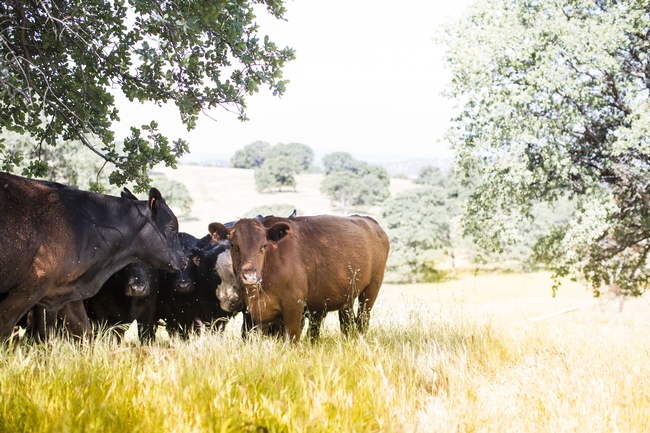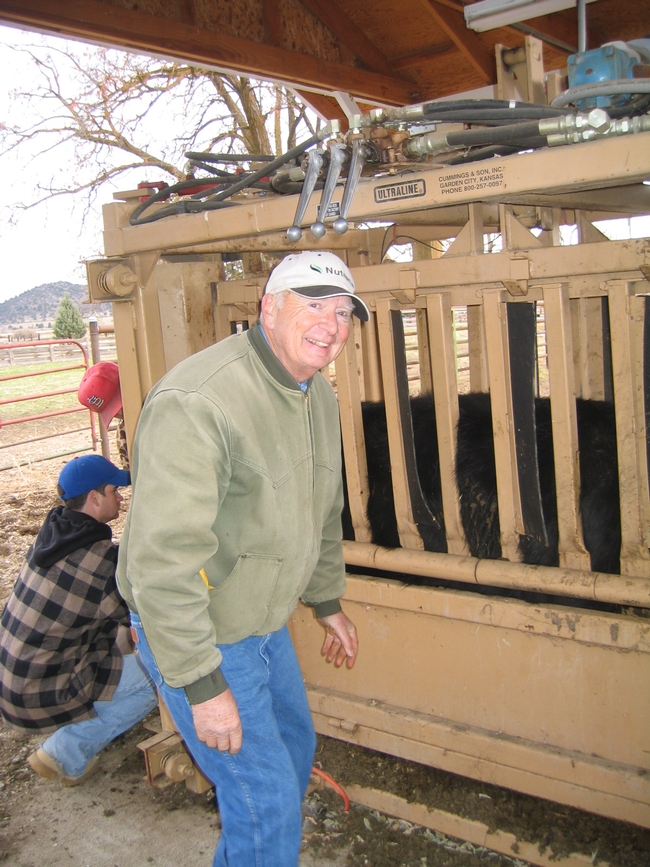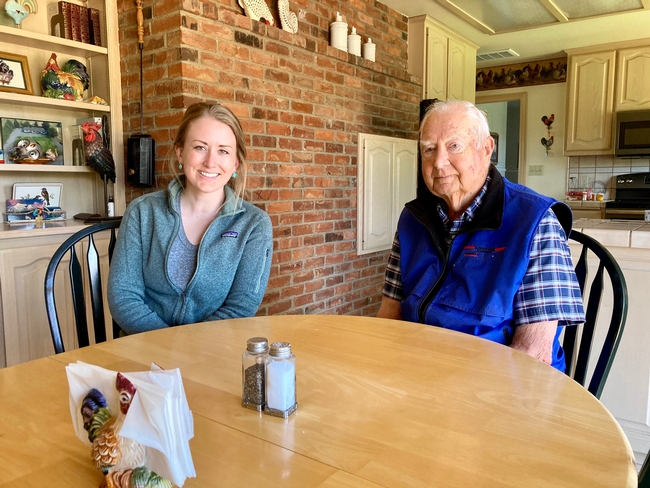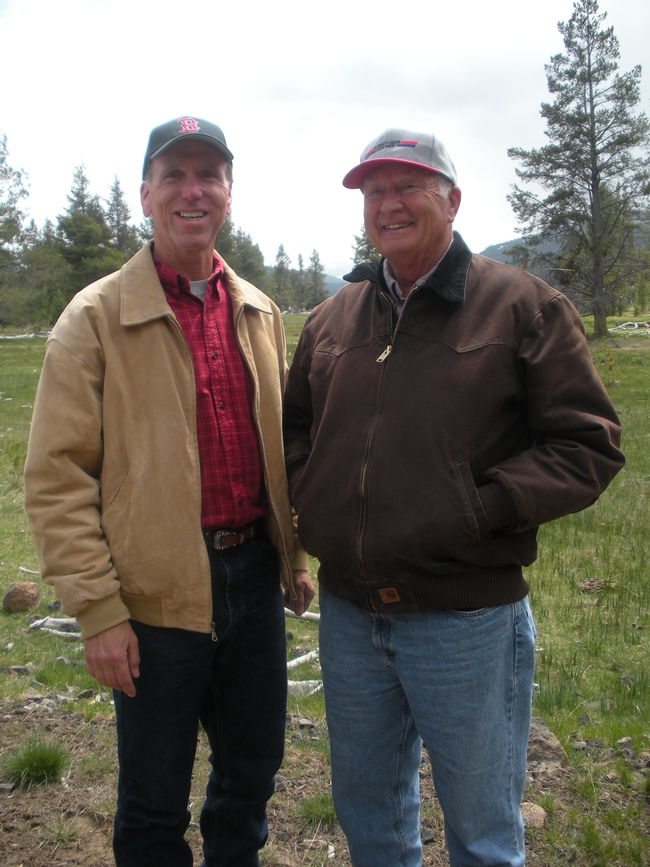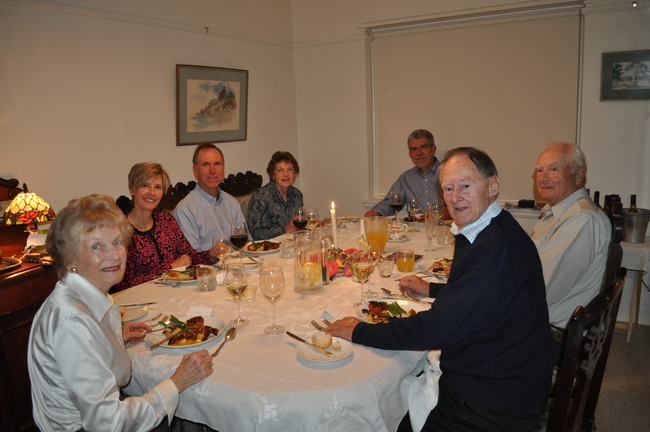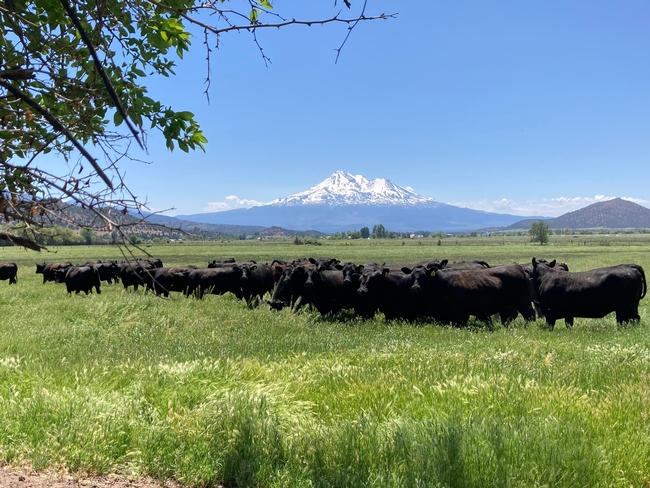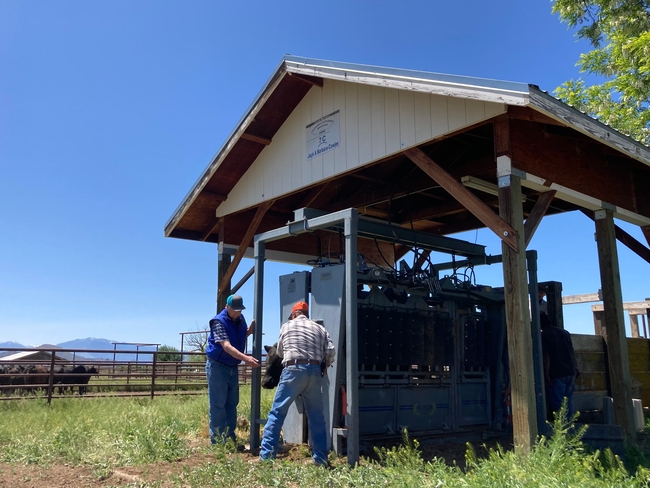Posts Tagged: Cattle
Fighting fire with feeding
Are cattle a secret weapon for taking on California wildfires?
California's cattle ranchers contribute a significant amount to the region's culture, economy and food supply, but do they also inadvertently help to temper the wildfires that have been plaguing the state? And if so, is it a better alternative – environmentally speaking – to letting grasslands burn?
A new study published in the journal Sustainability delves into the topic, weighing the advantages – and disadvantages – grazing cattle bring to the table. Researchers, including scientists from University of California, Davis and UC Agriculture and Natural Resources, set out to calculate the greenhouse gas emissions of cows consuming vegetation that would otherwise burn in wildfires. Then they estimated the GHG emissions that would result should that forage be untouched and therefore, consumed by fire, eventually comparing the two.
Feeling the burn
Given the severity of California's recent wildfires and the belief they will continue and even escalate in the near future, it's a discussion worth having, said Frank Mitloehner, an expert in animal agriculture and air quality from UC Davis, director of the CLEAR Center and one of the researchers who contributed to the peer-reviewed article.
“Each year from 2010 to 2020, California lost on average 89,000 acres of grassland to wildfires,” said Mitloehner, who is also a Cooperative Extension specialist. “In addition to the obvious disruption and devastation they caused, the fires spewed greenhouse gases and harmful particulate matter such as black carbon into the air and into our atmosphere. Those alone threaten climate health and human well-being.”
A fast and furious gas
Cattle are adept at eliminating herbaceous fuel as they graze. However, at the same time, their specialized digestive system produces methane that is expelled most often in the form of enteric emissions … more commonly known as belches. By way of background, methane is a potent greenhouse gas that warms the atmosphere at 25 times the rate of carbon dioxide over 100 years. But it's only in the atmosphere for 10 to 12 years after it's emitted. Following that, it's broken down into carbon dioxide and water vapor.
For that reason, Mitloehner refers to methane as a “fast and furious” gas. Furious because it warms with a vengeance and fast because it does so for only a short time, especially when compared to carbon dioxide. Furthermore, because of the biogenic carbon cycle, whereby plants extract carbon dioxide from the atmosphere for photosynthesis, the warming of methane and its byproducts can end entirely when it's hydrolyzed and used by plants.
How researchers calculated emissions
In order to determine if grazing, methane-emitting cattle are better for the atmosphere than burning grasslands, Mitloehner and the other researchers employed a method known as “Monte Carlo simulation,” a mathematical technique used by scientists to predict outcomes of an uncertain event.
Looking exclusively at methane emissions, they found it's better to have cows eat vegetation than to have wildfires burn it. Granted, it's only marginally better, but when one considers other advantages of animal agriculture and conversely, other disadvantages of widespread, uncontrolled fire, the conversation suddenly shifts.
“Even if cattle provided no other benefit to us, which certainly is not true, we can now make the case that they are helpful to us in yet another way,” Mitloehner said.
Friends or foes?
It goes without saying that one would be hard pressed to find much good to say about wildfires, but that doesn't hold true for animal agriculture. The industry provides jobs and supports the economy in other ways as well. Plus, it is a major source of protein-rich food that is in increasing demand as the world's population continues on a trajectory toward 10 billion people by the year 2050.
Where global warming is concerned, the industry is in the unique position of being able to reach net-zero warming, also known as climate neutrality, if it continues to aggressively chip away at its methane emissions, which Mitloehner asserts is of critical importance to the planet. “Few other sectors can reduce its warming to net zero and still be of service to society, but agriculture can because of the way methane behaves in the atmosphere,” he says.
To be clear, grazing cows are no match for wildfires. Yet, in addition to everything else the sector does for us, slowing the burn and keeping relatively more methane from entering the atmosphere are not nothing.
In addition to Mitloehner, authors of the study are Cooperative Extension advisors Sheila Barry, Devii Rao and Theresa Becchetti; Rowan Peterson, Ermias Kebreab and Minju Jung of UC Davis; and Felix Ratcliff and Kaveh Motamed of LD Ford.
This article was first published on the website of the CLEAR (Clarity and Leadership for Environmental Awareness and Research) Center at UC Davis.
Cattleman’s four decades of UCCE collaborations advance ranching practices
Siskiyou County rancher Jack Cowley has collaborated with UC Cooperative Extension scientists on research projects ranging from weed control to cow genetics for 40 years. The cooperation of farmers and ranchers is critical for producing practical research, scientists say. Photo by Alison Van Eenennaam
Eye doctor-turned-rancher brings science background to his second career
Siskiyou County rancher Jack Cowley, 91, joyfully recalled the special Christmas gift that delighted his seven children in the 1960s. Cowley, then a practicing eye doctor in Sacramento, and his late wife Barbara surprised the children with a white quarterhorse, which they named Silver.
“That's how it all started!” exclaimed Cowley, reflecting on the gift horse that would eventually lead to a 40-year collaboration with University of California Agriculture and Natural Resources.
Silver was the impetus for his family's involvement with the 4-H Youth Development Program, a part of UC ANR. Cowley also would later transition to a second career in cattle ranching, and collaborate with UC Cooperative Extension on research projects ranging from weed control to cow genetics.
“Jack has been an extremely committed supporter of UCCE,” said Grace Woodmansee, who became the UCCE livestock and natural resources advisor for Siskiyou County in 2021. “He has worked with UCCE extensively and contributed a lot of time and resources to supporting local and statewide projects.”
Lately Cowley and his son David have been working with Woodmansee and Gabriele Maier, UC Cooperative Extension specialist in the UC Davis School of Veterinary Medicine, on a cow deworming study.
Not only has Cowley allowed UCCE scientists to study his cattle over the years, he has been willing to personally share information with scientists and cattle producers across the country and internationally.
“It is important to foster exchange and linkages, said Dan Drake, UCCE farm advisor emeritus in Siskiyou County, who collaborated with Cowley for 30 years. “He went to so many meetings, especially with the early and uncharted areas of cattle genetics. Jack was on a first-name basis with the leaders from other states and the relationships were important in both directions. Frankly, I think many of those folks were jealous of the great cooperator we had in California.”
Breeding for better beef
After retiring from his Sacramento ophthalmology practice in the 1990s, Cowley settled in Montague in Siskiyou County, 246 miles north of the closest UC campus. There he met then-UC Cooperative Extension farm advisor Steve Orloff and Drake. Orloff advised him on alfalfa production and pasture management while Drake offered counsel on animal health records, organizing breeding, animal nutrition and water issues.
Drake explained to ranchers that by selectively breeding cows based on genetics, they could improve the production and quality of beef so that it's healthier for humans.
“My medical background helped me understand animal genetics,” Cowley said. “We can modify the genetics to improve the quality of the beef to make it more heart-healthy.”
In 2009, Drake introduced Cowley to UC Cooperative Extension specialist Alison Van Eenennaam, who studies animal genetics at UC Davis.
“I was looking to set up a research trial where we would follow cattle from the ranch all the way through to the Harris Ranch processing plant in the Central Valley,” said Van Eenennaam, who worked with Cowley on a three-year project.
Using DNA samples from Cowley's cattle, they evaluated the data they received from processor Harris Ranch of the beef characteristics – such as tenderness -- to compare the different breeds.
“I really thought I knew what I was doing and my cattle graded terribly,” Cowley said.
Since beginning the genetics project, his beef quality steadily improved.
“We're now up to where all of our animals are graded anywhere from 20% to 40% Prime and the rest Choice,” said Cowley, adding that he stopped striving for higher grades because the buyer said there was a limited market for the more expensive meat.
Cowley takes pride in knowing breeding practices developed from the research he and UC Cooperative Extension conducted have been adopted globally by dairy producers and beef producers.
“The type of research we were doing there has eventually evolved to now we have these genomic tests that you can use that genetically predict the performance of animals,” Van Eenennaam said. “Nowadays people just take an ear tag and send it in and get their genetic prediction.”
Van Eenennaam credits Cowley for allowing research on his large herd. “Jack was very patient with things that take a long time. When researchers come onto your ranch, that could slow you down.”
She added, “Genetic improvement, of course, is a huge component of sustainability because the more efficient cattle are, the less feed they consume and the less time they take to finish, which ultimately lessens their environmental footprint.”
Growing up in Utah
Looking back, Cowley marvels that he has been fortunate to do what he wanted to do in life.
“I was interested in ranching when I was probably seven or eight years of age,” said Cowley, who delivered the local Deseret Newspaper on horseback as a boy. “I grew up in Utah, you know, a little town in Utah called Holladay. It was not a ranching community.”
After serving four years in the Air Force during the Korean War, he returned to Utah to find the cute girl he met in first grade had graduated from college and was still single. He married Barbara in 1956. When he was accepted at George Washington University medical school, they drove with their three-week-old baby from Utah to Washington, D.C. He got a job in the Senate office building as an elevator operator working from 5 to 11 p.m., which enabled him to study, meet influential people and finish medical school without debt.
“I actually got to meet Khrushchev,” he said, recalling his encounter with the Soviet leader..
After finishing his ophthalmology residency at UCLA, Cowley established his practice in Sacramento and later taught a few classes at UC Davis Medical School.
Becoming a cattleman
One Saturday afternoon, after Silver the horse joined the family, Cowley and his oldest daughter, Kathryn, were driving in Placerville and saw a ranch for sale. He bought the 90 acres. For two summers, Barbara and the children lived at the ranch and Cowley joined them on weekends.
“Of course, I had to have a few cows to play with,” he said with a chuckle. “Basically, I thought I could make some money off of 50 cows.”
As his herd grew, he moved it to Corning, 50 miles south of Redding, and finally to the site in Montague that could accommodate several hundred head of cattle. “That's when I really became interested in animal genetics,” Cowley said. “That was back when we had slide rules to do our calculations. It was pretty crude, but it was a start.”
In 1990, Cowley was honored as the California Beef Cattle Improvement Association's Seedstock Producer of the year and, in 2007, was named Siskiyou County's Cattleman of the Year. He has served as president of the Siskiyou County Cattlemen's Association, on the Cattlemen's Beef Board, as well as on committees for the National Cattlemen's Beef Association.
“Jack spent countless hours traveling to the Midwest and other beef research institutions to share knowledge, learn more and plan for needed information,” said Drake, emeritus UCCE livestock advisor. This made for better Extension work, better research and recognition of UC Cooperative Extension work nationwide.”
In 2011, when Van Eenennaam and Drake presented their research at an international genomics conference, he joined them in Australia to learn from other researchers. They also visited Australian producers to learn their practices.
“We really rely on cooperators like Jack to enable our research to have translation to farmers and ranchers,” Van Eenennaam said.
In recent years, Cowley has handed the ranch reins over to his children David, Brian, Brent and Kathryn, who live in Siskiyou County.
David, who retired from a nearly 40-year career as a software engineer, plans to continue working with UC Cooperative Extension advisors and specialists.
“Any time you have questions, you can call and they're more than happy to help you,” he said.
Commercial Ranchers in Mendocino and Lake Reminder
I wanted to make sure you saw the final reminder for the climate-smart ag survey from UC Rangelands below. We want to make sure commercial-scale producers are well-represented in the responses.
Please click bit.ly/rangeland23 to take the survey by May 15, 2023.
Thank you!
Climate-Change Resources
University of California UC ANR Green Blog (Climate Change and Other Topics) https://ucanr.edu/blogs/Green/index.cfm?tagname=climate%20change (full index)
Examples:
- Save Trees First: Tips to Keep Them Alive Under Drought https://ucanr.edu/b/~CdD
- Landscaping with Fire Exposure in Mind: https://ucanr.edu/b/~G4D
- Cities in California Inland Areas Must Make Street Tree Changes to adapt to Future Climate https://ucanr.edu/b/~oF7
Drought, Climate Change and California Water Management Ted Grantham, UC Cooperative Extension specialist (23 minutes) https://youtu.be/dlimj75Wn9Q
Climate Variability and Change: Trends and Impacts on CA Agriculture Tapan Pathak, UC Cooperative Extension specialist (24 minutes) https://youtu.be/bIHI0yqqQJc
California Institute for Water Resources (links to blogs, talks, podcasts, water experts, etc.) https://ciwr.ucanr.edu/California_Drought_Expertise/
UC ANR Wildfire Resources (publications, videos, etc.) https://ucanr.edu/News/For_the_media/Press_kits/Wildfire/ (main website)
-UC ANR Fire Resources and Information https://ucanr.edu/sites/fire/ (main website)
-Preparing Home Landscaping https://ucanr.edu/sites/fire/Prepare/Landscaping/
UC ANR Free Publications https://anrcatalog.ucanr.edu/ (main website)
- Benefits of Plants to Humans and Urban Ecosystems: https://anrcatalog.ucanr.edu/pdf/8726.pdf
-Keeping Plants Alive Under Drought and Water Restrictions (English version) https://anrcatalog.ucanr.edu/pdf/8553.pdf
(Spanish version) https://anrcatalog.ucanr.edu/pdf/8628.pdf
- Use of Graywater in Urban Landscapes https://anrcatalog.ucanr.edu/pdf/8536.pdf
- Sustainable Landscaping in California https://anrcatalog.ucanr.edu/pdf/8504.pdf
Other (Non-UC) Climate Change Resources
Urban Forests and Climate Change. Urban forests play an important role in climate change mitigation and adaptation. Active stewardship of a community's forestry assets can strengthen local resilience to climate change while creating more sustainable and desirable places to live. https://www.fs.usda.gov/ccrc/topics/urban-forests
Examining the Viability of Planting Trees to Mitigate Climate Change (plausible at the forest level) https://climate.nasa.gov/news/2927/examining-the-viability-of-planting-trees-to-help-mitigate-climate-change/
Reports and other information resources coordinated under the auspices of the United Nations and produced through the collaboration of thousands of international scientists to provide a clear and up to date view of the current state of scientific knowledge relevant to climate change. United Nations Climate Action
Scientific reports, programs, action movements and events related to climate change. National Center for Atmospheric Research (National Science Foundation)
Find useful reports, program information and other documents resulting from federally funded research and development into the behavior of the atmosphere and related physical, biological and social systems. Search and find climate data from prehistory through to an hour ago in the world's largest climate data archive. (Formerly the "Climatic Data Center") National Centers for Environmental Information (NOAA)
Think tank providing information, analysis, policy and solution development for addressing climate change and energy issues (formerly known as the: "Pew Center on Global Climate Change"). Center for Climate & Energy Solutions (C2ES)
Mapping Resilience: A Blueprint for Thriving in the Face of Climate Disaster. The Climate Adaptation Knowledge Exchange (CAKE) was launched in July 2010 and is managed by EcoAdapt, a non-profit with a singular mission: to create a robust future in the face of climate change by bringing together diverse players to reshape planning and management in response to rapid climate change. https://www.cakex.org/documents/mapping-resilience-blueprint-thriving-face-climate-disaster
Cal-Adapt provides a way to explore peer-reviewed data that portrays how climate change might affect California at the state and local level. We make this data available through downloads, visualizations, and the Cal-Adapt API for your research, outreach, and adaptation planning needs. Cal-Adapt is a collaboration between state agency funding programs, university and private sector researchers https://cal-adapt.org/
Find reports, maps, data and other resources produced through a confederation of the research arms of 13 Federal departments and agencies that carry out research and develop and maintain capabilities that support the Nation's response to global change. Global Change (U.S. Global Change Research Program)
The Pacific Institute is a global water think tank that combines science-based thought leadership with active outreach to influence local, national, and international efforts to develop sustainable water policies. https://pacinst.org/our-approach/
Making equity real in climate adaptation and community resilience policies and programs: a guidebook. https://greenlining.org/publications/2019/making-equity-real-in-climate-adaption-and-community-resilience-policies-and-programs-a-guidebook/
Quarterly CA Climate Updates and CA Drought Monitor Maps (updated each Thursday) https://www.drought.gov/documents/quarterly-climate-impacts-and-outlook-western-region-june-2022
Drought focus of Water Resources IMPACT magazine special issue
UC ANR experts address emotional toll of drought
Preparing the American West for prolonged drought is the focus of a double issue of Water Resources IMPACT magazine. The California Water Commission staff are guest editors for this special open-access edition of the magazine, which is published by the American Water Resources Association.
Faith Kearns, academic coordinator of University of California Agriculture and Natural Resources' California Institute for Water Resources, is among the authors delving into how drought impacts people and the environment and how we can better prepare for the inevitable.
The first issue, published on Feb. 14, focuses on water scarcity issues confronting California and the ways these issues affect different sectors.
In “Trauma, Care, and Solidarity: Addressing the Emotional Toll of Chronic Drought,” Kearns highlights the effects of drought on mental health. She points to the spike in suicide hotline calls when wells ran dry in Southeast Asian communities in California's Central Valley.
By listening to Southeast Asian farmers, Ruth Dahlquist-Willard and Michael Yang of UC Cooperative Extension were able to “lighten the load” for them by providing pragmatic support, Kearns writes.
“The scale of some of these highly emotional issues – drought, wildfires, climate change – can make them seem incredibly difficult, if not impossible, to deal with,” Kearns said. “At the same time, they are affecting everyone living in the western U.S. on a daily basis. I wanted to highlight and provide models based on work that people – whether they are researchers, clinical psychologists, or Cooperative Extension advisors – are doing right now to ease the way.”
The authors who contributed to the double issue are a diverse array of Tribal experts, academics, nongovernmental organization thought-leaders, water managers and water policy influencers, each of whom brings their own perspective on the topic of drought. Their expertise and perspectives in climate science, water policy and water management will help inform drought-related decision-making and support policies that better prepare the state to thrive during periods of prolonged water scarcity.
In addition to Kearns, the first issue includes articles contributed by:
- Samantha Stevenson, University of California, Santa Barbara
- Jay Lund, University of California, Davis
- Ron Goode, North Fork Mono Tribe
- Andy Fecko, Placer County Water Agency
- Jeff Mount, Public Policy Institute of California, and Ted Grantham, University of California, Berkeley/UC Cooperative Extension
- Nat Seavy and Karyn Stockdale, National Audubon Society
- Kjia Rivers, Community Water Center
- Cannon Michael, Bowles Farming
- Michelle Reimers, Turlock Irrigation District
The January/February edition of Water Resources IMPACT magazine can be accessed, free of charge, on the American Water Resources Association website at https://www.awra.org under “Publications.”
The second issue, to be published in March, will focus on drought response, considering the options for adaptation. This two-part series complements the Commission's work on strategies to protect communities and fish and wildlife in the event of a long-term drought.

